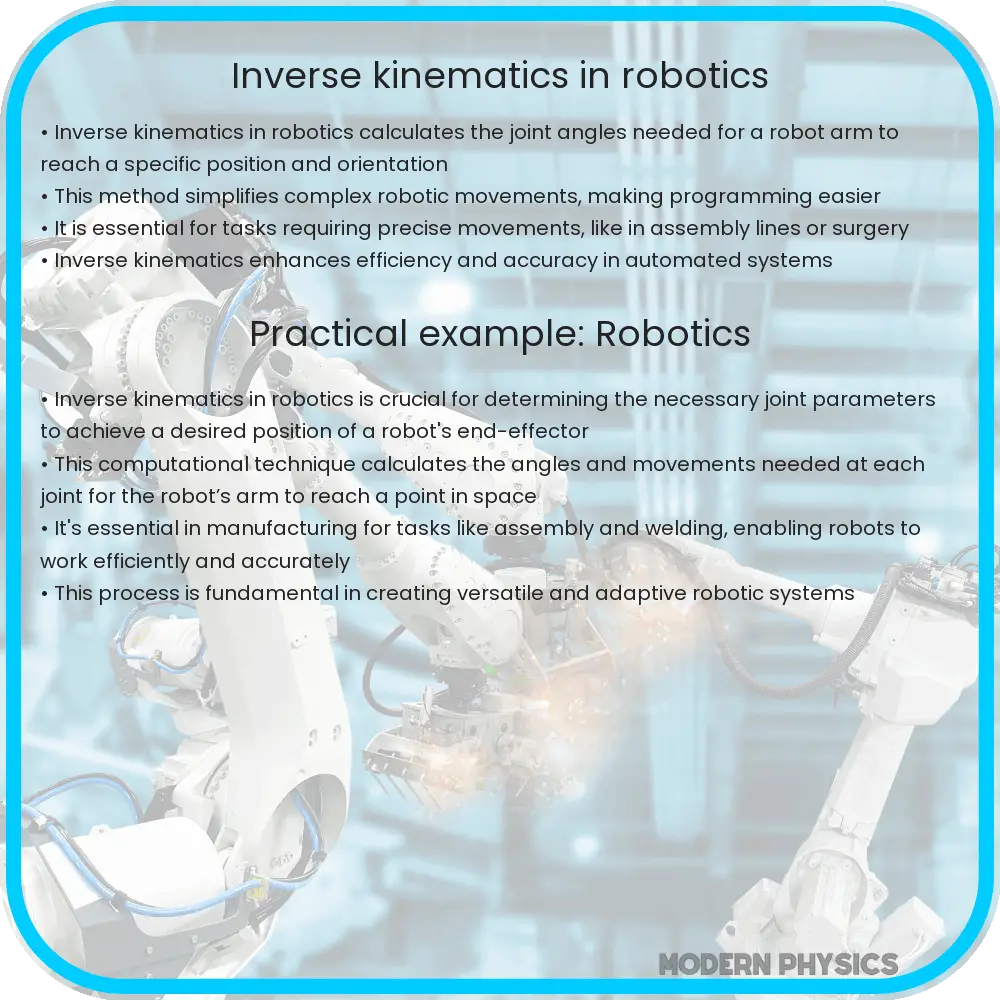Explore the role of inverse kinematics in robotics for enhanced precision and control, its applications in various fields, and future advancements.

Understanding Inverse Kinematics in Robotics
In the realm of robotics, inverse kinematics (IK) plays a pivotal role in enhancing the precision and control of robotic arms and mechanisms. This mathematical concept is fundamental in programming robots to reach a desired position or follow a specific path with high accuracy. Understanding IK is crucial for developing robots that can perform complex tasks in various fields, including manufacturing, medical surgery, and more.
The Basics of Inverse Kinematics
Inverse kinematics is a method used to calculate the necessary joint angles to place the end of a robotic arm (the end-effector) at a desired location in space. Unlike forward kinematics, where the position of the end-effector is determined based on given joint angles, IK works in the opposite direction. It starts with a desired position and then calculates the joint angles that will achieve that position.
One of the main challenges in IK is that there are often multiple solutions for a given position. This is because a robotic arm can reach the same point in space with different configurations. Therefore, additional criteria, such as the smoothest or most efficient path, are often used to select the best solution.
Applications of Inverse Kinematics in Robotics
IK is integral to various robotic applications:
- Precision in Manufacturing: In industries like automotive and electronics, robots must perform tasks with high accuracy. IK algorithms enable robots to assemble parts with precision, leading to improved product quality and efficiency.
- Medical Robotics: In surgical robotics, IK allows for precise movements, essential for delicate procedures. It enables surgical robots to navigate through tight spaces and perform intricate operations with minimal invasiveness.
- Animation and Gaming: IK is also used in computer graphics to animate characters. By defining the end position of limbs, animators can create more natural and realistic movements.
Advantages of Inverse Kinematics in Robotics
Implementing IK in robotics systems offers several benefits:
- Improved Precision: By calculating the exact joint angles needed for a specific position, IK enhances the precision of robotic movements.
- Better Control: With IK, operators can focus on the end-goal position, making it easier to control the robot’s movements.
- Efficient Path Planning: IK algorithms can help in determining the most efficient path for the robot’s movement, reducing energy consumption and wear and tear on the robot.
While inverse kinematics significantly improves the functionality of robotic systems, it is not without challenges. The complexity of calculations, especially in robots with many degrees of freedom, requires robust algorithms and powerful computing resources. Furthermore, ensuring the stability and smoothness of movements in real-world applications continues to be an area of ongoing research and development.
Challenges and Future Directions in Inverse Kinematics
Despite its many advantages, inverse kinematics in robotics also faces several challenges. The primary issue lies in the complexity of calculations involved, particularly in robots with a high number of degrees of freedom. This complexity can lead to computational intensity, requiring advanced algorithms and significant processing power. Additionally, ensuring accuracy in dynamic environments where external factors such as obstacles or varying loads come into play, remains a hurdle.
Future advancements in IK are expected to focus on improving real-time responsiveness and adaptability. With the integration of machine learning and AI, robots could learn to adjust their movements dynamically, enhancing efficiency and effectiveness in unpredictable environments. This evolution would be particularly beneficial in fields like search and rescue operations, where adaptability to unstructured environments is crucial.
Integrating Inverse Kinematics with Other Robotic Technologies
Another aspect of advancing IK in robotics is its integration with other technologies. For instance, combining IK with sensors and vision systems can enable robots to react to their environment in real time. This integration is particularly vital in collaborative robotics, where robots work alongside humans and must adapt to human movements and environmental changes.
Furthermore, the incorporation of haptic feedback mechanisms can enhance the capabilities of surgical robots, allowing surgeons to feel the resistance and texture of tissues, thus improving the precision and safety of medical procedures.
Conclusion
Inverse kinematics stands as a cornerstone in the field of robotics, driving advancements in precision, control, and efficiency. Its applications span from manufacturing and medical robotics to animation, showcasing its versatility and impact. While challenges remain, particularly in computational complexity and adaptability, the future of IK is promising. The integration of AI and machine learning, along with other emerging technologies, is set to revolutionize how robots interact with their environment and execute tasks. As we continue to push the boundaries of what robots can do, inverse kinematics will undoubtedly play a crucial role in shaping the future of robotics and automation.
In conclusion, the journey of inverse kinematics in robotics is an ongoing one, marked by constant innovation and improvement. As technology progresses, we can expect to see more sophisticated and intuitive robotic systems, underpinned by the principles of IK, transforming industries and everyday life alike.
